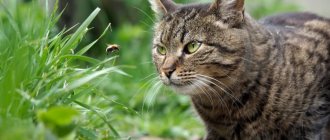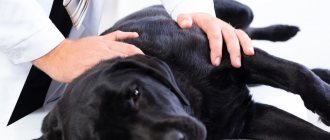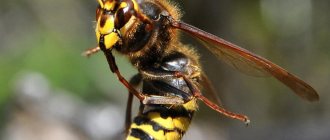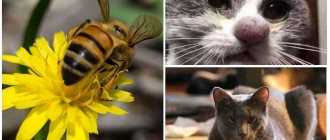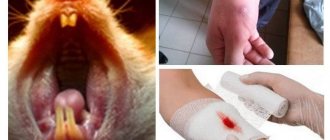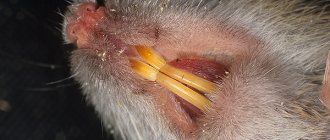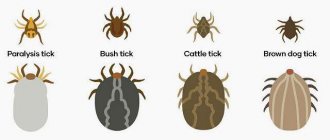The consequences of a wasp sting for kittens and allergy-prone pets can be tragic, even fatal. Therefore, in such a situation, you need to provide first aid to the animal as soon as possible. In addition, in some cases you cannot do without a veterinarian.
Let's find out what parts of a cat's body bites can lead to death and what needs to be done to save the pet.
Why is insect venom dangerous?
When a wasp bites, it inserts its sting into the skin and releases poison, which includes biologically active substances and enzymes. If they enter the bloodstream, they can cause serious health problems:
- Melitin. A toxin that destroys red blood cells, disrupts local metabolism in tissues, makes the walls of blood vessels permeable and contributes to the development of the inflammatory process.
- Histamine. It is a mediator of allergic reactions. It tones smooth muscles, expands capillaries and promotes the permeability of their walls, causing tissue swelling. Histamine also lowers blood pressure.
- Hyaluronidase. This is an enzyme that breaks down mucopolysaccharides and increases tissue permeability, which contributes to the spread of edema.
A bee or wasp sting can cause an allergic reaction, followed by intoxication of the body, and then anaphylactic shock.
A wasp sting is especially dangerous, since the venom of this insect is more toxic than that of a bee. When it gets into the skin it causes a strong burning sensation. The pain syndrome persists for several hours. However, this is not the main danger.
A Hymenoptera bite to the head or neck area is fraught with swelling, which can spread to the respiratory system and cause an attack of suffocation. No less dangerous is poison getting into the groin. In this case, swelling will obstruct the flow of urine. A bite to the eyelid can cause severe inflammation of the eye and can even lead to loss of vision.
Prevention
It is almost impossible to completely protect your cat from being bitten, but when he spends the summer season outdoors, the possibility of insect damage should be minimized. For this:
- The windows are covered with mosquito nets, the doors are hung with curtains;
- Periodically inspect the territory, destroy existing bee nests;
- Treat pets with repellents.
It is not recommended to feed cats outside; here it is much easier for insects to get into the food, and accordingly the risk of being struck by a wasp is much greater.
How to tell if a cat has been bitten by a wasp
Due to the thick fur, a wasp bite on a cat’s body is quite difficult to detect. If the owner was nearby during the insect attack, he will notice the pet's strange behavior. The cat will jump sharply to the side due to severe pain, begin to meow loudly and behave aggressively - hissing, scratching or biting.
Lameness is a sign that the sting has gotten into the paw. If a wasp stings a cat in the face, redness and swelling will appear almost immediately. In any case, cats that have been bitten do not behave as usual. The animal does not allow itself to be examined, it breaks out and licks the sore spot if it can reach it.
First reaction
First, redness appears at the site of the wasp or bee sting. The pet experiences itching and pain, like after a burn. Swelling gradually appears at the site of the bite. Sometimes it is small and resembles a lump the size of a nut. In some cases, the surrounding tissues greatly increase in size.
The stung animal tries to scratch, lick or even chew the affected area. To relieve pain, the cat presses against a cool surface - the ground, the floor.
Symptoms that appear over time
Some time after a wasp sting, your cat may show signs of an allergic reaction:
- hives;
- increased salivation;
- increased body temperature;
- difficulty breathing, wheezing or gurgling sounds;
- convulsions;
- loss of consciousness.
Signs of anaphylactic shock
Persians, Britons and Angora cats are prone to allergic reactions, so they are at increased risk if they are stung by a wasp. They can quickly experience anaphylactic shock and death. An attack by stinging insects is also dangerous under the following conditions:
- age up to 6 months;
- recently had an infectious disease or surgery;
- presence of chronic diseases;
- gender – in males, allergies occur more often than in females, and are more severe;
- A hypersensitivity reaction to insect venom had previously been observed.
Attention! Multiple wasp stings are more dangerous than single ones, especially for a kitten. In this case, more toxic substances enter the blood, therefore increasing the risk of developing a severe reaction.
Pain and itching after a bite are not life-threatening for the cat. The discomfort will go away in a few hours. The real threat is anaphylactic shock.
It manifests itself:
- lethargy, inhibited reactions;
- blanching of the mucous membranes;
- chills, increased heart rate;
- wheezing;
- weak and frequent pulse;
- vomiting;
- involuntary urination.
Attention! In most cases, anaphylaxis develops rapidly – a few minutes after a cat is bitten by a wasp or bee. In some animals, the reaction may take several hours to appear. It is very important to carefully monitor the cat's condition so that if signs of anaphylactic shock occur, help can be provided quickly.
Where do they bite most often?
If there is a suspicion that the cat was stung by wasps, then the entire body should be completely examined. In long-haired pets you may not see swelling.
However, most often arthropods injure the pads of the front paws and the area of the nasolabial triangle, since it is with these parts of the body that the cat tries to catch the insect. A little less often they bite just above the pads and in the muzzle.
Hymenoptera bite in other places much less frequently, since indiscriminate biting is only done by an angry individual, and the injured animal immediately runs away after the first bite. The remaining areas of the body are protected by a thicker coat. The exception is hairless breeds.
Frequent bite sites
Most often, wasps bite cats on the limbs, because the animals hunt for insects and often crush them with their paws. Other common places where insects sting pets are in the head area:
- nose;
- lip;
- cheek;
- chin;
- eyelid;
- mouth
The greatest danger is caused by wasp stings in the muzzle area. If the poison gets into the tongue, lip or nose, the risk of swelling of the laryngeal tissue increases. In this case, the source of inflammation is immediately noticeable - a painful lump appears on the face. Some cats' entire heads become enlarged.
Sometimes wasps sting cats on the tongue. This happens if a pet tries to eat prey. Bites in the mouth can result in the death of the animal (due to swelling of the throat and trachea). Therefore, it is very important to examine the inside of the mouth and cheeks. The owner of the animal should be alert to increased salivation, the inability to close the mouth, noisy breathing with whistling or wheezing.
A bite to the eye will manifest itself as an increase in the volume of the eyelid and a narrowing of the palpebral fissure. Swelling can spread to the frontal part of the head, cheekbones and underarms. This often leads to the development of conjunctivitis and other serious consequences.
If the paw pads become red and very swollen, the cat may have been bitten on the paw by a wasp. A stung pet will not be able to step on it, but will limp or drag its leg behind it.
If the animal is not prone to allergic reactions, a bite on the paw will not lead to dangerous consequences.
In rare cases, wasps sting cats in the abdomen and groin area. For example, when a pet lies down on the grass on which an insect is sitting. Bees rarely bite cats on other parts of the body - hips, shoulders, back or neck.
Why do cats bite?
Cats can, of course, become aggressive when they are scared or feel threatened. But many also tend to bite and scratch when petted by their owner. This is called petting-induced aggression, and it has been a topic of discussion among behaviorists for decades. There are three theories why cats do this. First, they are simply letting their owner know that they are no longer happy to be petted. Secondly, they are trying to establish their status. Thirdly, a person who pets them for a while causes negative emotions in cats. It is important for owners to learn more about their cats in order to recognize the telltale signs of aggression caused by petting.
What to do if a cat is bitten by a wasp
After an insect attack on a pet, you need to urgently provide him with help. What to do if a cat is bitten by a wasp:
- place it in a cool place and ensure peace;
- examine the bite site;
- remove the sting and treat the wound;
- prevent swelling from spreading.
First aid
The first thing you need to do at home is to remove the sting if it remains in the wound. This usually happens when a cat is stung by a bee. Its self-defense weapon is equipped with serrations that do not allow the insect to pull it out after an attack.
The bee tries to free herself with all her might, but this leads to the stinger being torn off from her body along with part of her body. For this reason, the insect soon dies, and the sting remains in the skin of the victim.
If a cat is bitten by a bee on the paw or body, you can remove the sting yourself. To do this you will need tweezers. It is advisable to pre-treat it with an antiseptic.
- The stuck sting needs to be grabbed as close to the pet’s skin as possible and pulled out. We must try not to disturb its integrity: if you crush the sting, even more poison will get into the wound.
- Next, you need to squeeze the skin near the bite site with your fingers so that a drop of blood is released - along with it a portion of toxic substances will be released.
- Immediately after this, it is advisable to give the cat the homeopathic remedy Apis mellifica. It eliminates pain, burning and prevents the spread of swelling from insect bites. The dosage is minimal - dissolve 3-5 granules in 10 ml of water and pour into the cheek from a syringe without a needle.
During the procedure, the cat should be restrained and try to calm it down. Because of the pain, he will struggle and may become aggressive. If there is someone else nearby, it is better to enlist their support.
Treatment of the bite site
After removing the sting, it is important to ensure that the swelling does not spread. A cold compress will help with this. You will need ice, which should be wrapped in a plastic bag or cloth and applied to the bump for 10 minutes. Thanks to the cold, the capillaries will narrow, this will help relieve swelling and eliminate pain.
After this, you should treat the bite site with a soda solution (1 teaspoon per 200 ml of water). Other means will also work:
- soap solution;
- table or apple cider vinegar diluted with water 1:1;
- water with the addition of citric acid (a pinch per 100 ml);
- citrus juice.
Attention! A cat bite should be examined every 30 minutes. If the swelling continues to increase, veterinary attention will be needed.
In most cases, cats recover quickly from wasp or bee attacks. If the pet is feeling normal, there is no shortness of breath and no signs of hyperthermia, then it is recommended to lubricate the bite site with Fenistil-gel or Bepanten ointment 2-3 times a day. Usually this is enough. After 2-3 days, there will be no trace of unpleasant symptoms.
Allergy
Swelling from a bee sting is already a sign of a serious problem. If this is all you need to do, you can cope without specialized help. But when a tumor of the larynx, vomiting or diarrhea, and heart rhythm disturbances are added to this, it is worth talking about an allergic reaction. It is no longer possible to do without the use of antihistamines.
At home, homeopathic remedies such as Apis tablets will help prevent the development of a reaction when a cat is stung by a bee. You can also give Tavegil, Suprastin, Diazolin or Diphenhydramine.
If a bee gets stung in the face or enters the oral cavity, it is recommended to use the following remedies:
- a Prednisolone tablet is crushed into powder, diluted with water and poured into the cat’s mouth; if this option does not help, take the drug in an ampoule and inject the medicine;
- if you have nausea, vomiting, or difficulty breathing, you will need a Dexamethanose injection;
- If you are allergic to bee stings, L-cet suspension helps.
If these medications do not provide relief and the allergic reaction continues to worsen, medical attention will be needed.
L-cet
What not to do
When helping a cat after a wasp sting, it is important not to harm it. What not to do:
- apply a cloth moistened with dirty water from a pond or reservoir to the wound;
- lubricate the bite site with irritating ointments that contain essential oils or menthol;
- independently resuscitate your pet if there are symptoms of anaphylaxis;
- giving your cat pills intended for humans without your veterinarian's permission;
- You should not allow your cat to scratch the lump; you may have to wear a protective collar.
Tags
the cat was bitten by a wasp Consequences of a wasp sting When a wasp stung A bee sting A hymenoptera sting Urine. A bite in a cat was bitten by a wasp wasp bite wasp bite place of a wasp sting Cats Cats Cats Cats' bodies can be detected by a cat's body bitten cats lead angora cats have if a cat was bitten when a cat was bitten by a wasp bite by a wasp kitten the bite of a wasp stings or wasps can Particularly dangerous wasp bitten by a wasp sting for cats Grooming cats Feeding cats Neutering cats for cats lives of cats for cats Grooming cats A bee sting or than a bee. or a bee appears or a bee. bitten by a bee. A bee tries to bite a bee
pawallergiesbreathingcauseanimaldiseasesstungdoctoreyesrodentsorganismyoursuchcommentillnessothersimmediatelyanyveterinarian
Pharmacy products
There are no special medications for cats.
- To eliminate minor allergies, creams based on medicinal herbs, tinctures, Zvezdochka balm, Bepanten, Menovazin are used.
- To eliminate moderate allergies, Fenistil gel is used.
- With a pronounced clinical picture, antiallergic hormonal ointments are required - Advantan, Elokom, Betamethasone, Triaccutane.
- If an infection gets into the wound, the sore spots are treated with a local antibiotic - Levomekol, Tetracycline, Erythromycin, Gentamicin.
The cat's skin should be treated 1-4 times a day; as the symptoms disappear, the dosage is reduced. Therapy lasts no more than 5 days. If the situation does not improve within 2 days, you need to show the cat to a veterinarian.
When to go to the vet
In the following situations, you need to immediately take the animal to a veterinarian:
- a wasp/bee bit a small kitten;
- the bite was in the head area, and especially somewhere in the neck;
- a severe allergic reaction with angioedema and difficulty breathing is visible;
- the organ of vision was damaged (bite directly in the eye);
- Some time after the bite, the cat loses its appetite, apathy appears, the temperature of the whole body rises, and the place where the insect stung swells or begins to fester.
What the veterinarian urgently introduces:
- prednisolone: 0.5-1 ml subcutaneously/intramuscularly;
- dexamethasone: 0.2-1 ml subcutaneously/into the muscle;
- Benadryl (diphenhydramine, diphenhydramine): 0.5-1 ml intramuscularly;
- Diazolin: ½ tablet orally. or pills, but only in cases where there is no swelling of the pharynx and swallowing is not difficult;
- aminophylline: 0.1-0.5 ml into the muscle or subcutaneously to improve ventilation in case of swelling of the airways.
- adrenaline 0.1% - administered in particularly urgent cases of anaphylaxis. The dosage is determined only by a veterinarian in each individual case, because If the calculation is incorrect, you can get the opposite effect.
In most cases, the cat’s body copes with wasp and bee stings on its own - swelling, swelling, pain, lameness subside and disappear within 2-7 days (up to a maximum of 10 with increased individual sensitivity of the body). Cases when urgent veterinary care is required are quite rare, but every cat owner should be able to figure out when it is really needed.
Author:
Grinchuk Ekaterina Andreevna veterinarian
